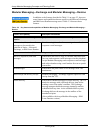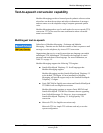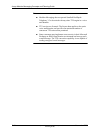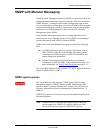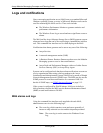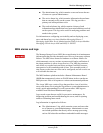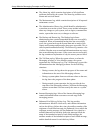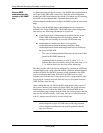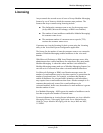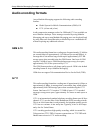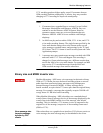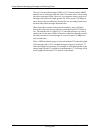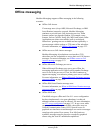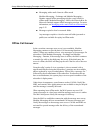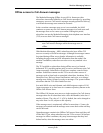
Avaya Modular Messaging Concepts and Planning Guide
5-16 November 2004
Avaya Modular Messaging Concepts and
Planning Guide
How an NMS
acknowledges the
receipt of an SNMP
trap
An NMS can acknowledge the receipt of an SNMP alarm trap defined in
an Avaya SNMP MIB with a return trap. With this acknowledgement
method, the NMS acknowledges the receipt of an alarm trap by returning
an SNMP acknowledgment trap. Customers that opt for this
acknowledgment method must configure the NMS to generate such return
traps.
The objects that the SNMP alarm acknowledgment trap contains are
defined in the Avaya SNMP MIB. The SNMP alarm acknowledgement
trap conveys the following information in its payload:
! A notification object inadssnmpAck, as defined in the Avaya
SNMP MIB. inadssnmpAlarmAck describes whether the
manager has successfully received the SNMP alarm trap.
! inadssnmpAck contains two objects in its payload,
inadssnmpAlarmAck and inadssnmpAlarmTime. Both
inadssnmpAlarmAck and inadssnmpAlarmTime are defined in
the Avaya SNMP MIB.
— The value of inadssnmpAlarmTime must be the same as that
passed in the SNMP alarm trap.
— inadssnmpAlarmAck returns a value of either "so 2 " to
indicate that it has successfully received the alarm trap, or "so
3 " to indicate that it has not received the alarm trap.
The MAS and the MSS can also be configured to consider an SNMP trap
acknowledged using a ping surround method. With this acknowledgment
method, the MAS and the MSS generate a ping command to the NMS,
prior to sending an alarm trap. If the MAS and MSS receive a ping
response, they send the trap. If they do not receive a ping response, they
keep trying at 5-minute intervals until they receive a response from the
NMS, and then send the trap.
After sending the trap, the MAS and MSS send another ping request. If
they receive another ping response from the NMS, the system assumes
that the trap was received on the NMS. If the MAS and MSS do not
receive another ping response from the NMS, the system assumes that the
trap was not sent successfully. In this case, the trap is rescheduled to be
sent at 5-minute intervals until it is successfully sent.
Note: Avaya encourages customers to use return traps to
acknowledge the receipt of SNMP traps, as the ping surround
acknowledgment method does not actually guarantee that the
trap was received.



